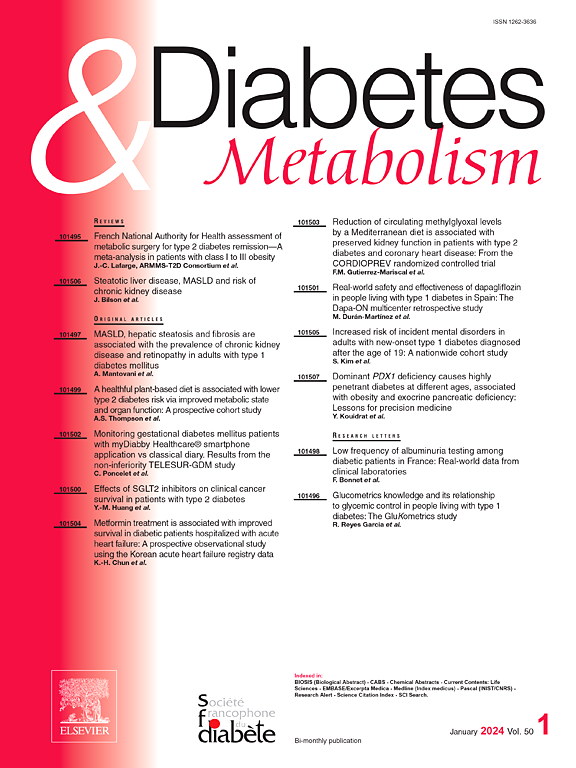GLP-1受体激动剂和糖尿病视网膜病变是敌是友?
IF 4.7
2区 医学
Q1 ENDOCRINOLOGY & METABOLISM
引用次数: 0
摘要
随着全球糖尿病患者数量的不断增加,糖尿病视网膜病变(DR)患者数量也在不断增加,影响着患者的生活。胰高血糖素样肽-1受体激动剂(Glucagon-like peptide-1 receptor agonists, GLP-1RAs)是一种模拟内源性胰高血糖素样肽-1作用的降糖药物,可显著改善2型糖尿病患者的血糖控制。GLP-1RAs通过激活视网膜内皮细胞和神经细胞中的GLP-1受体,抑制RhoA/ROCK信号通路,上调紧密连接蛋白occludin和ZO-1,抑制小胶质细胞的活化,减少促炎因子的释放,减少神经炎症和血管渗漏,从而修复血视网膜屏障功能。然而,一些GLP-1RAs可能会增加DR的风险,如糖尿病性黄斑水肿和增殖性DR,并可能增加DR恶化的风险,特别是在血糖快速降低期间。虽然新型GLP-1/GIP双受体激动剂和GLP-1/GIP/胰高血糖素三受体激动剂通过有效改善机体代谢显示出综合获益潜力,但短期内血糖突然下降的负面影响仍需引起重视。对于中重度DR患者,需加强眼科监测,避免初始治疗时血糖迅速下降。在长期治疗中,需要权衡代谢益处和视网膜风险,治疗前需要评估患者的病情。因此,GLP-1RAs对DR具有“机制保护和临床风险”的双重作用,个体化治疗策略应综合考虑药物特性、DR严重程度和血糖控制情况。本文章由计算机程序翻译,如有差异,请以英文原文为准。
Are GLP-1 receptor agonists and diabetic retinopathy foes or friends?
With the increasing number of patients with diabetes worldwide, the number of patients with diabetic retinopathy (DR) is also increasing, which affects the lives of patients. Glucagon-like peptide-1 receptor agonists (GLP-1RAs) are anti-diabetic drugs that mimic the action of endogenous glucagon-like peptide-1, which significantly improve glycemic control in patients with type 2 diabetes. GLP-1RAs can repair the blood-retinal barrier function by activating the GLP-1 receptor in retinal endothelial cells and nerve cells, inhibiting the RhoA/ROCK signaling pathway, up-regulating the tight junction protein occludin and ZO-1, and inhibiting the activation of microglia, reducing the release of pro-inflammatory factors, and reducing neuroinflammation and vascular leakage. However, some GLP-1RAs may increase the risk of DR, such as diabetic macular edema and proliferative DR, and may increase the risk of DR deterioration, especially during rapid glucose lowering. Although the new GLP-1/GIP dual-receptor agonists and GLP-1/GIP/glucagon tri-receptor agonists show comprehensive benefit potential by effectively improving body metabolism, the short-term negative effect of sudden blood glucose drop still needs to be paid attention to. For patients with moderate to severe DR, it is necessary to strengthen ophthalmic monitoring to avoid rapid blood glucose decline in the initial treatment. In the long-term treatment, metabolic benefits and retinal risks need to be weighed, and the patient's condition needs to be evaluated before treatment. Therefore, GLP-1RAs has a duality of "mechanism protection and clinical risk" on DR, and individualized treatment strategy should take into consideration drug characteristics, DR severity and glucose control.
求助全文
通过发布文献求助,成功后即可免费获取论文全文。
去求助
来源期刊

Diabetes & metabolism
医学-内分泌学与代谢
CiteScore
12.00
自引率
4.20%
发文量
86
审稿时长
13 days
期刊介绍:
A high quality scientific journal with an international readership
Official publication of the SFD, Diabetes & Metabolism, publishes high-quality papers by leading teams, forming a close link between hospital and research units. Diabetes & Metabolism is published in English language and is indexed in all major databases with its impact factor constantly progressing.
Diabetes & Metabolism contains original articles, short reports and comprehensive reviews.
 求助内容:
求助内容: 应助结果提醒方式:
应助结果提醒方式:


